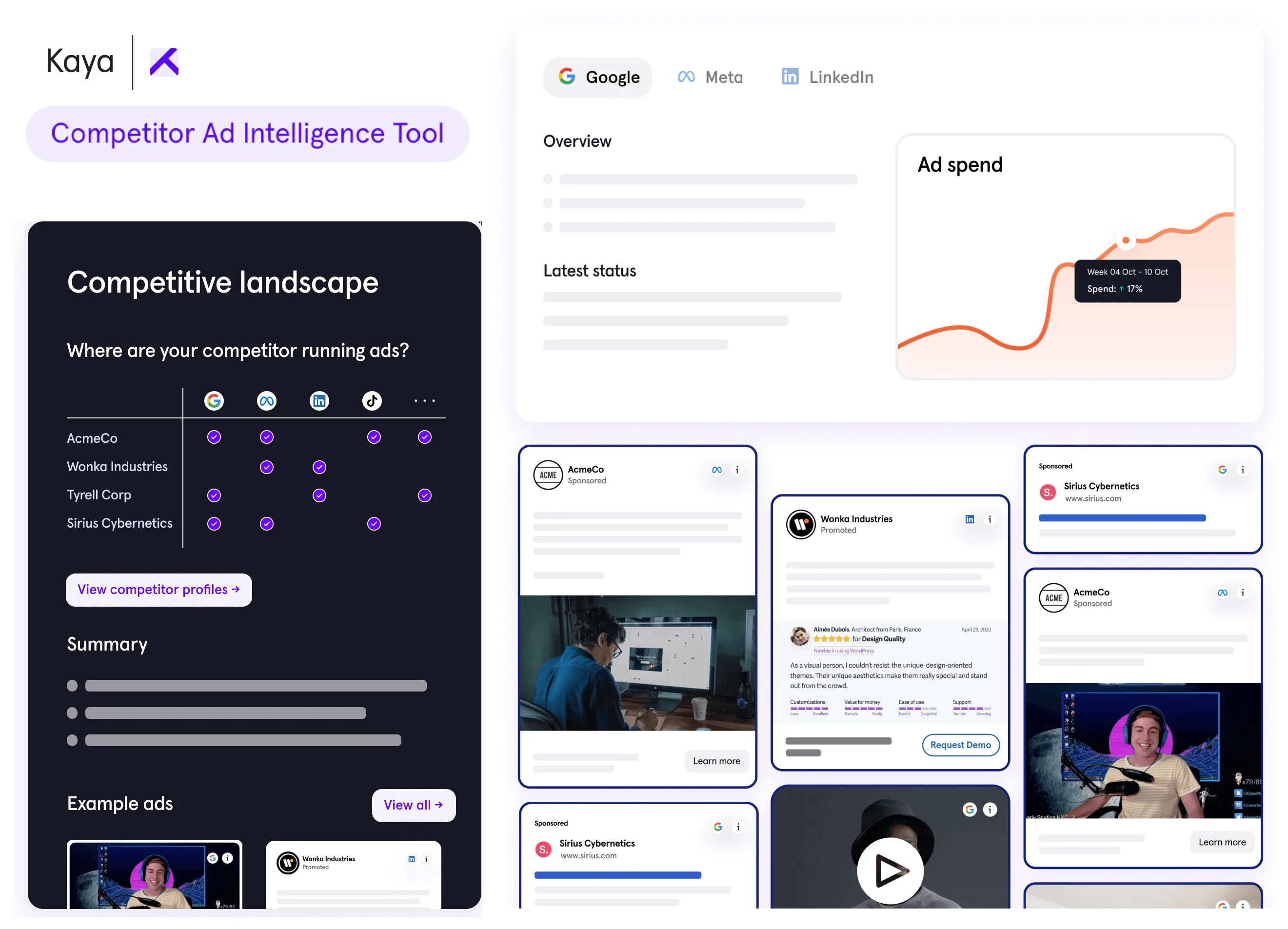Paid ads are essential to startups because they get your products or services in front of your ideal target audience. However, choosing the right platform can be challenging as you need to balance your business goals, budget, and audience targeting.
Keep reading to learn about each paid ad platform and how to choose the most suitable one for your startup.
Paid ad platform categories
How paid search works: PPC, keyword bidding, and Ad Rank explained
Paid search platforms like Google and Bing operate on a pay-per-click (PPC) model, where advertisers only pay when someone clicks on their ad. These ads are shown based on keyword bidding, where you bid on search terms your target audience is likely to use.
Each time a search occurs, an ad auction determines which ads appear, using three core factors:
- Your bid amount
- Ad relevance and quality (Quality Score)
- Expected click-through rate (CTR)
Google then calculates an Ad Rank, which determines both your position and how much you pay per click. You don’t necessarily pay your full bid, the actual CPC is influenced by competition and relevance.
Effective paid search campaigns rely on:
- Choosing the right match types (broad, phrase, exact, negative)
- Writing high-CTR ad copy
- Targeting keywords with strong commercial intent
This is what makes paid search ideal for intent-driven traffic. You’re reaching people actively looking for what you sell.
Mapping ad platforms to funnel stages and audience intent
Not all ad platforms serve the same purpose in the buyer journey. Some are better for discovery and brand awareness, while others are best at converting users already in-market.
Here’s how different platforms align with funnel stages and searcher intent:
| Platform | Funnel stage | Intent type |
|---|---|---|
| Google Ads | Bottom-of-funnel (BOFU) | High intent, transactional searches |
| Bing Ads | BOFU | Similar to Google, lower CPC |
| Mid-to-bottom funnel | Warm audiences, retargeting, lookalikes | |
| Top-to-mid funnel | Brand discovery, lifestyle visual interest | |
| Mid funnel | B2B awareness + lead gen | |
| TikTok | Top-of-funnel (TOFU) | Passive, interest-based discovery |
Startups can use this mapping to sequence their paid ads strategy — from attracting new eyes to closing high-intent leads.
Types of major ad platforms and their analyses
Each paid ad channel has different strengths and is suitable for different goals, outlined in table below.
| Platform | Target audience | Budget | Strength | Weaknesses |
|---|---|---|---|---|
| Active audience searching for solutions. Suitable for intent-based targeting |
|
|
|
|
| Caters to an older audience |
|
|
|
|
| Young, active, and trendy audience |
|
|
|
|
| B2B-focused. Professional, career-minded audience |
|
|
|
|
| TikTok | Young, active, and trendy audience that likes to consume bite-size videos and memes |
|
|
|
The Google Ad platform is effective for targeting intent-based searchers who are actively seeking solutions. It can be the right platform to sell quickly. There are many available formats, such as text, image, video, responsive, app promotion ads, shopping ads, and call-only ads. Google Ads attract an average click-through rate (CTR) of 4-6% and up to 800% ROI.
Facebook Ads are suitable for when you need to zoom in on specific audiences. You can target in-depth and segment by specific demographic and psychographic features. Available formats include carousel, slideshow, collection, instant experience, poll, and messenger ads. The clickthrough rate (CTR) for Facebook Ads stands at around 2.5%, while the conversion rate gets up to 8.25% across industries.
Instagram Ads are suitable for advertising with visually compelling content. They are also ideal for a young and engaged crowd, especially within the creative industries. Travel, food, fashion, and skincare brands are among the top Instagram advertisers.
The LinkedIn platform is ideal for targeting professionals across industries. It is a suitable ad platform for B2B marketing, lead generation, and brand awareness.
TikTok
TikTok is ideal for startups that want to reach a young, trendy, and active crowd, like Gen Z. It is also suitable for bite-sized and short-form video content and memes. It has massive viral potential.
Popular ad formats across paid ad platforms
Each platform supports unique ad formats that can influence engagement and performance. Here’s a breakdown of the most common ones:
| Platform | Ad formats |
| Google Ads |
|
| Facebook Ads |
|
| Instagram Ads |
|
| LinkedIn Ads |
|
| TikTok Ads |
|
Selecting the right format depends on your goal — whether it’s clicks, conversions, video views, or brand recall.
Essential factors in choosing paid ad platforms
The campaign objectives provide a guideline that serves as a pointer for the most suitable ad platforms for startups. Having a clear objective is always the first place to start.
Campaign objectives
Before starting a paid ad campaign, you need to outline your goals. Your goal is a desired future state, and having one enables you to create the right motivations and pathway. You can start with a simple question. What do we want to achieve? This could be any of the following;
- Brand awareness
- Lead generation
- Direct sales
Your goal determines your paid ad strategy, messaging, and the type of creative you will deploy. It is also essential for resource allocation, performance tracking, and choosing the right channel.
Target audience
To create a target customer profile, consider where your target audience hangs out the most. Study their conversations to understand their pains, what matters to them, how they like to be spoken to, and their motivations. Here are a few extra points to consider.
| Platform | Considerations |
|---|---|
| You can find targets based on topics and active searches for products or services. Search intent takes precedence over demographics. So, ensure you target keywords that are relevant to your audience search. | |
| You can target by demography, interest, behavior, custom audiences, and lookalike audience. The lookalike audience feature targets people who share similar features with your existing customers. The demographic is more evenly spread compared to Instagram. | |
|
Shares similarities with Facebook as they are both under the Meta ad network. However, Instagram resonates more with a younger audience. 62% of Instagram users are between 18 to 34 years old. |
|
| LinkedIn would suffice if you’re in the SaaS or professional services niche with a B2B focus. It offers a professional context, allowing you to target organizations or individuals by their education, job experience, and demographic details. | |
| TikTok |
TikTok mostly caters to a younger crowd, too. 70% of TikTok users are between 18 to 34 years old. It is suitable for startups targeting young, tech-savvy individuals who like to consume short-form videos. |
Budget considerations
Factor in your budget when selecting an ad platform, as each platform has unique cost structures and minimum spend requirements. Here are some rule of thumbs when it comes to budgeting:
- If you’re just starting out, consider allocating an amount that's manageable enough to risk, yet substantial enough to collect meaningful data
- If your budget is too low, it takes longer for the ads platform to optimize your campaigns, thus lower performance and slower learning for you
- If your budget is too high, your ROI will be low as paid ads is subjected to the law of diminishing return
- For Paid Search: High budget for product with low search volume means that ads will show for random low intent keywords
- For Paid Social: High budget for product with small audience means that ads will either be (1) shown to random people or (2) very frequently to the same group of people, making them desensitised or even have negative sentiment to the brand
The cost structure, budget control, and flexibility of each ad platform are broken down below:
| Platform | Cost structure / control |
|
The cost per click (CPC) for most businesses is between $0.11 and $0.50 per click on Google Ads, according to Web FX. You can set daily budgets to as low as $1, as there is no minimum entry budget. You can use features like budget allocation to manage your ad spending. |
|
|
Facebook Ads cost between $0.26 and $0.30 per click and $1.01 to $3.00 per 1000 impressions. There are also features to help you manage budgets, such as automatic bidding, manual budding, and campaign budget optimization (CBO). |
|
|
Instagram Ads cost around $0.20 to $2.0 per click, while CPM averages around $6.70. Like other ad networks, your industry, bid, and other factors also come into play in ad pricing. |
|
|
The average cost per click on LinkedIn is around $5.26 for sponsored posts and $6.59 per 1000 impressions. LinkedIn also offers the bid type option, ad scheduling, and budget adjustments. |
|
| TikTok |
TikTok Ads require a minimum campaign budget of $50 and a $20 ad group budget. For web conversion campaigns, TikTok recommends a $30 minimum daily ad group budget for North America and EMEA brands, and $20 for APAC brands. |
The above averages are only indicative and will vary based on your industry, targeting, ad type, bid, and other factors.
Platform strengths and limitations
By assessing the pros and cons of each ad platform, you can strengthen your decision-making. Here are some points to note:
| Platform | Pros & cons |
| Suitable for matching audience search intent. Delivers high-quality leads. However, it is highly competitive, and keywords with high volumes can be costly. | |
| Offers extensive targeting and high engagement. Suitable for broad and precise targeting and supports various ad creative formats. However, it is prone to frequent algorithm changes and ad fatigue. | |
| Instagram offers great visual appeal and leverages the Meta network. It also offers high engagement and shopping features. However, it is also prone to frequent algorithm changes, and link options are limited to large profiles—limiting direct traffic to websites. | |
| Most ideal for a professional audience. Offers accurate targeting and quality leads, but it is more expensive and delivers less engagement than Google and Facebook. | |
| TikTok | Suitable for an audience that is more active and engaged. It’s easier to go viral compared to other channels. However, it may be more expensive and has limited analytic capabilities. Non-video ad formats tend to underperform due to the platform’s nature. |
Competitors
Where your competitors advertise can be a good indicator of where your customers are. Hence, you can take inspiration from that rather than trying to reinvent the wheel, especially when you’re new to paid ads. You can draw insights from competitor ad analysis to inform your paid ad strategy.
Implementing and optimizing your ad strategy
Start with a test budget
Start small. Calculate the CPL for each channel and focus on channels with lower costs but sizable reach. Allocate a budget for at least 3 months to achieve cost efficiency, as ad platforms need time to understand your data.
Make data-driven decisions
Focus on a data-driven approach to improve decision-making accuracy and speed. Review historical ad performance data and also consider an A/B test.
Optimize campaigns consistently
Regularly audit your ad campaigns and also use the results of an A/B test to improve your ad strategy. Analyze competitor ads and be willing to reallocate ad budget to better-performing campaigns.
Consider multi-platform strategies
Depending on your niche, goal and target audience, you want to start with a cost-effective ad platform. So, you may start with Google Ads to see how its intent-based audience responds to your key messaging (e.g. keywords, ad copies). Focus on identifying and crafting the right messaging for your target audience.
When using Google Ads, it's important to use keywords that are relevant to your product or service. Don’t just focus solely on high competition keywords, as they tend to be more expensive to bid on.
On Facebook, you can use the lookalike audience feature to target people who interact with your Google Ad and landing page. You can also use the Meta pixel feature to build an ideal profile. That will enable you to optimize your ad for the future or to re-engage or remarket your audience.
Benefits of cross-platform strategies include:
- Increased reach and more ad exposure.
- More flexibility in your ad strategy.
- Reduced dependency on one platform.
- Better learning and iteration.
Analytics and attribution tools to improve ROI
To optimize your paid ads performance, install tracking tools that give you accurate data:
- Google Ads: Use Google Tag Manager and GA4 for conversion tracking
- Facebook/Instagram: Install the Meta Pixel to measure on-site actions
- LinkedIn: Use Insight Tag to track B2B lead performance
- TikTok: Use TikTok Pixel and Event Manager
Also, consider your attribution model. Platforms often use last-click attribution by default, which may not show the full funnel impact. Switching to a data-driven or linear attribution model can give a more balanced view.
Combine analytics with A/B testing (testing copy, creatives, audiences) to optimize your campaigns over time.
Don’t forget about data privacy and compliance
As you run paid ad campaigns, especially across platforms like Meta and TikTok, it’s important to stay compliant with data protection laws such as:
- GDPR (General Data Protection Regulation – Europe)
- CCPA (California Consumer Privacy Act)
- IAB TCF v2.2 (Transparency & Consent Framework)
- First-party vs third-party data policies
Some platforms (like Google and Meta) offer tools such as Consent Mode, cookie consent banners, and Consent Management Platforms (CMPs) to help you comply.
Failing to follow these requirements can lead to reduced ad reach, poor targeting, and even legal issues. So make privacy part of your marketing foundation.
Tips for optimizing ad performance across different platforms
When advertising across multiple platforms, understand that each platform is unique and deploying one strategy may not be the best thing to do. Instead;
- Set clear KPIs for each platform.
- Maintain consistent brand messaging across platforms.
- Follow algorithm changes of each platform.
- Use platform-specific tools to improve your ad copy and creatives.
Case study
Kaya offers end-to-end paid ads management for startups, including B2B tech startups and B2C YC-backed startup clients. Our Competitor Ad Intelligence Tool plays a key role in the process. We consolidate your ads from Google Transparency Center and Meta ads Library and use that for further analysis.
For Google Ads: We use our AI-driven Competitor Ad Intelligence Tool to analyze competitors’ keyword strategies and ad spending. Using the insights derived, we have helped our clients to expand their reach and increase signups.
- For Meta ads: We analyze competitors' ad types, messaging, and offers. Then, we identify successful themes, targeting, and longest-running ads. This allows us to create fresh and engaging ad content and creatives for our clients, helping them overcome creative blocks.

With Kaya's Competitor Ad Intelligence Tool, you can see all your competitors' ads across different platforms in one place.
FAQ
How to choose an ad platform?
What is the best ad platform for startups?
What are the two key factors to consider when choosing an advertising platform?
What is the best paid advertising?
What is the best form of paid advertising?
Which ads are most profitable?
Final thoughts
Google, Meta, LinkedIn, and TikTok ad platforms all have unique qualities and ad budgeting structures. By choosing the right ad platforms, you can find their ideal targets, connect with them, and manage their ad budget effectively.


